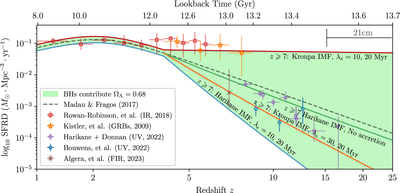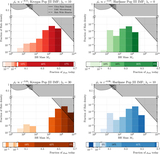Image Details

Caption: Figure 2.
Cosmic star formation rate densities (SFRDs) capable of producing the necessary k = 3 BH density to give ΩΛ = 0.68 (green, solid). The details of the model are given in Appendix A. The upper bound of the viable region adopts a Kroupa (2002) initial mass function (IMF) at all redshifts with the least amount of remnant accretion required to produce ΩΛ with a decreasing power-law SFRD model (red, solid). The lower bound adopts the top-heavy IMF of Harikane et al. (2022a) at z > 7 (blue, solid). Two middle lines show the impact of a top-heavy IMF at z > 7, but no remnant accretion (green, solid); and higher accretion, but with a Kroupa IMF (orange, solid). Existing measurements of the SFRD via IR (Rowan-Robinson et al. 2018, red, squares), γ-ray bursts (Kistler et al. 2009, orange, stars), FIR (Algera et al. 2023, brown, xs), and rest-frame UV via the JWST (Harikane et al. 2022a; Donnan et al. 2022, purple, dots), (Bouwens et al. 2022, blue, dots) are over-plotted. The UV points can vary ∼−1 dex depending upon IMF assumptions and UV luminosity integration bounds. Consistency occurs with consumption of <3% of the baryon fraction Ω b after cosmic dawn. The results assume stellar first light at z ⋆ = 25 (Harikane et al. 2022b, Figure 25) but are typical of the scenario for 15 < z ⋆ < 35. Also indicated are the redshifts probed by 21 cm experiments.
Copyright and Terms & Conditions
© 2023. The Author(s). Published by the American Astronomical Society.





